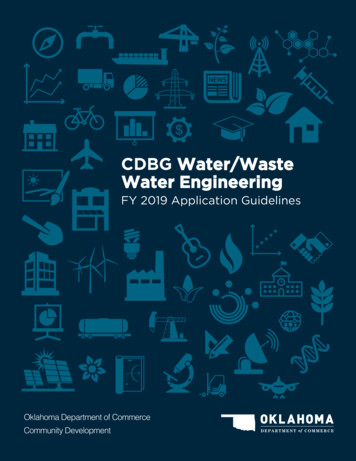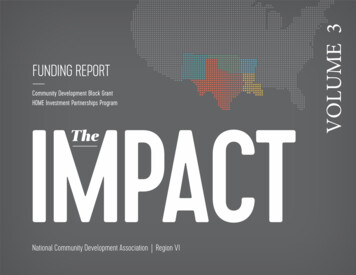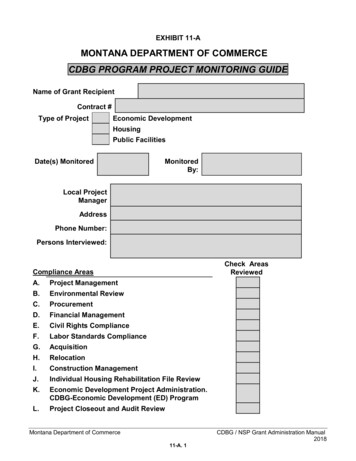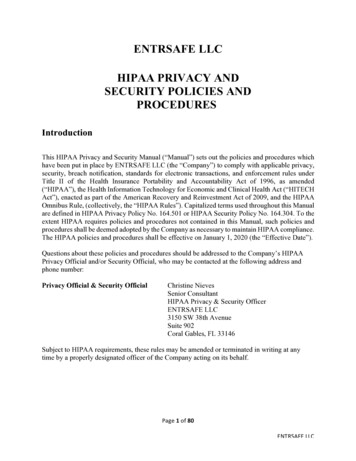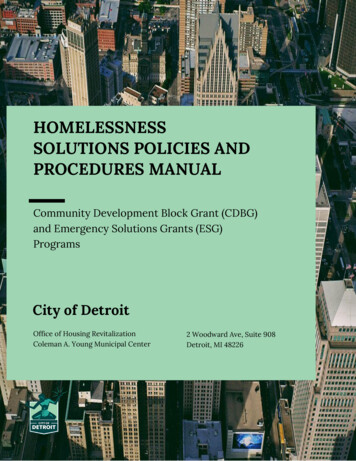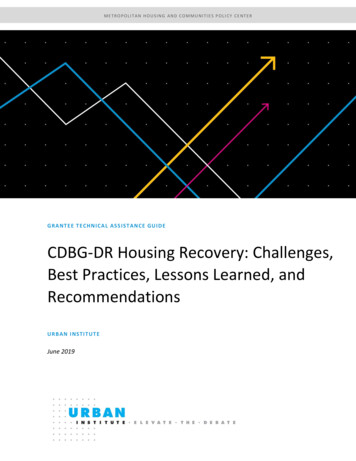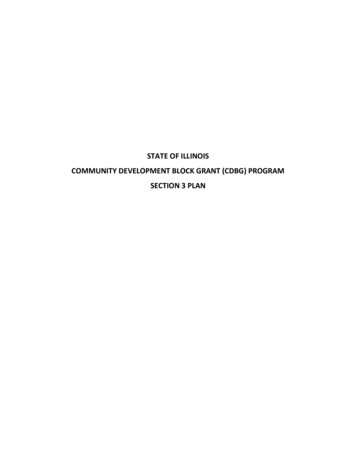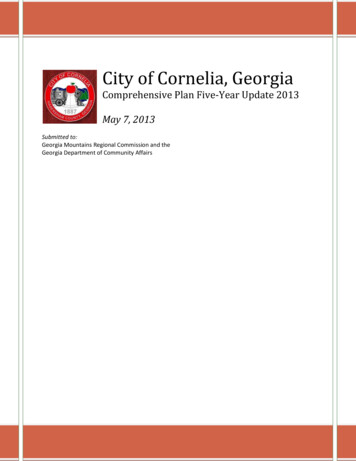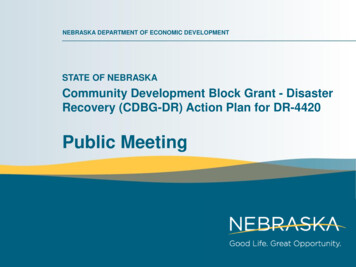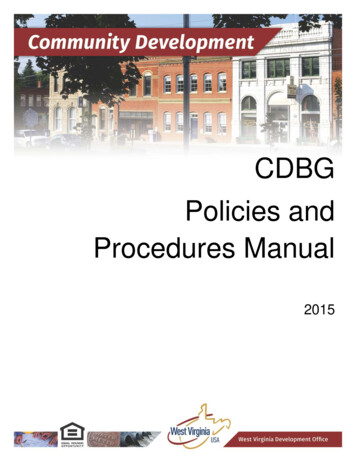
Transcription
CDBGPolicies andProcedures Manual2015
CDBG Policies and Procedures ManualTable of ContentsPageIntroduction.1Chapter One–Project Administration.1-1Chapter Two–Environmental Review .2-1Chapter Three –Financial Management .3-1Chapter Four–Program Income .4-1Chapter Five–Professional Services .5-1Chapter Six–Construction Management .6-1Chapter Seven –Labor Compliance .7-1Chapter Eight–Civil Rights .8-1Chapter Nine–Monitoring, Reporting & Closeout .9-1Chapter Ten–Acquisition of Real Property .10-1This CDBG Policies and Procedures Manual is intended as a guide, not as a substitute for athorough knowledge of state and federal laws and regulations referenced in this manual. In theevent of any discrepancy, federal regulations will prevail. The Grantee is responsible forcompliance with the most current and stringent of any applicable local, state or federal law orregulation(s).The West Virginia Development Office does not discriminate on the basis of age, race, color,religion, sex, national origin, familial status or disability in the admission, access to, treatment of,or employment in, its federally assisted programs or activities.
Introduction
IntroductionThe Community Development Block Grant Program (CDBG) is administered by the U.S.Department of Housing and Urban Development (HUD), and is authorized under Title 1 of theHousing and Community Development Act of 1974 (HCDA), as amended.Prior to the HCDA, there were numerous Federal programs which addressed communitydevelopment issues. The CDBG program was developed through the consolidation of variousprograms under which communities previously competed for funds. These programs included:Open Space, Urban Renewal, Neighborhood Development Program grants, HistoricPreservation grants, Model Cities supplemental grants, Public Facilities loans, NeighborhoodFacilities grants; and Water and Sewer grants.The primary objective of Title 1 of the HCDA is the development of viable urban communities.These viable communities are achieved by providing the following, principally for persons of lowand moderate income:1. Decent housing;2. A suitable living environment;3. Expanded economic opportunities.To achieve these goals, the CDBG statutory and regulatory requirements set forth eligibleactivities and National Objectives that each activity must meet. The U.S. Department of Housingand Urban Development has established the following three National Objectives for the CDBGprogram. Each CDBG-funded activity must meet one of HUD‟s three National Objectives.Therefore, each project must:1. Benefit low and moderate income individuals;2. Aid in the prevention or elimination of slum and blight; or3. Meet other community development needs having a particular urgency due toexisting conditions that pose a serious and immediate threat to the health orwelfare of the community where other financial resources are not available.From 1975 to 1981, states did not participate in the CDBG program. Instead, HUD conductedan annual competition to fund small cities. Amendments to the HCDA in 1981 permitted statesto administer the CDBG program for small cities, beginning in 1982. In West Virginia, theprogram is commonly known as CDBG-Small Cities.The State program is designed to provide assistance to units of local government to improveeconomic opportunities and meet community revitalization needs, primarily for individuals of lowand moderate income.Under Title I of the HCDA, all units of general local government are eligible to apply for CDBGfinancial assistance, except for the West Virginia cities that participate in the CDBG EntitlementProgram and receive CDBG funds directly from HUD. These include: Beckley, Charleston,Huntington, Martinsburg, Morgantown, Parkersburg, Vienna, Weirton and Wheeling.1 PageCDBG Manual (June 2015)West Virginia Development Office
IntroductionAfter CDBG funds are allocated to Indian Tribes (one percent of the Congressional allocation);funds are then split among entitlement communities and states, with 70 percent of fundsdedicated to entitlement communities and 30 percent of funds dedicated to states.Funds are allocated based upon a formula which factors total population, percent of populationin poverty and housing. Therefore, funding allocations vary from year to year.The West Virginia Development Office (WVDO), Project Development Section, is given theprimary responsibility for the administration of the CDBG program at the State level. The WVDOis responsible for developing the consolidated plan; designing the program; reviewingapplications; distributing funds; establishing financial management, reporting, monitoring, audit,and closeout procedures; and ensuring the compliance of CDBG grant recipients.HUD is responsible for monitoring the states to ensure compliance with CDBG programrequirements. The regulations implementing the CDBG Program are found in the Code ofFederal Regulations: 24 CFR Part 570.Meeting a National ObjectiveEvery CDBG-funded activity must meet one of HUD‟s three National Objectives. The NationalObjective category must be identified in the grant application prior to the award of funding,however, the National Objective is not met until the grant recipient carries out the activity, andthe closeout reports document how the National Objective was met, and accepted. This requiresthat each activity meet specific tests for either: Benefit low and moderate income individuals; Aid in the prevention or elimination of slum and blight; and Meet other community development needs having a particular urgency due toexisting conditions that pose a serious and immediate threat to the health orwelfare of the community where other financial resources are not tedClienteleSlum/BlightHousingJobsArea BasisUrgentNeedSpot BasisEach of the three National Objectives, and the subcategories of criteria for how that objectivemay be met, is described on the following pages.2 PageCDBG Manual (June 2015)West Virginia Development Office
IntroductionBenefit to Low and Moderate Income IndividualsThe Benefit to Low and Moderate Income Individuals (also known as Low/Mod or LMI Benefit) isreferred to as the “primary” National Objective because Federal regulations require that 70percent of CDBG funds meet this National Objective. Within this National Objective, there arefour subcategories:1.2.3.4.Low Mod Area (LMA)Limited Clientele (LMC)Low Mod Housing (LMH)Low Mod Job Creation and Retention (LMJ)Public facilities activities, such as water, sewer and storm water projects, generally qualify underthis National Objective; providing area wide benefit to LMI persons. The „benefit to LMI persons‟test is met by documenting - through census data or an income survey – that 51 percent ormore of the persons who live in the project area may be defined as being low-to-moderateincome.For this purpose, LMI determination is based upon the income of a family, household, orindividual living in the CDBG-Small Cities project area whose household income does notexceed 80 percent of the median income for the area. As defined, this means the activitybenefits all residents in a particular area or neighborhood, where at least 51 percent of theresidents are LMI persons. Note, the LMI determination for all subcategories under this NationalObjective, is based upon low to moderate income persons, with only one exception. The LowMod Housing (LMH) is the only National Objective based upon households, rather thanindividuals.In some limited circumstances, the project may qualify under the Limited Clientele criteria.These projects typically serve a specific group of individuals in a community but not necessarilythe entire community. HUD has designated eight limited clientele groups that automaticallyqualify as meeting the benefit of low-to-moderate income persons test. These groups are:abused children; battered spouses; senior citizens (62 and over); illiterate adults; severelydisabled adults; the homeless; persons with HIV-AIDS; and migrant farm workers.Elimination of Slums and Blighted ConditionsPublic and/or private facilities requiring improvements that aid in the prevention or elimination ofslums or blighted conditions in a designated slum/blight area may qualify for funding under theNational Objective of Elimination of Slum and Blight Area Basis. Such projects would includedemolition of multiple downtown buildings. Improvements could also be for a single building notlocated in a blighted area, and in such case, the project would qualify under the Spot Basis.Urgent Need ProjectsIf the improvement corrects a CDBG-defined urgent situation, the Urgent Need NationalObjective may be met. West Virginia seldom funds Urgent Need projects. In cases whereUrgent Need projects have been funded, they typically addressed disaster relief or recovery.3 PageCDBG Manual (June 2015)West Virginia Development Office
IntroductionDetermining LMI EligibilityThere are two ways to verify that proposed projects meet the National Objective of benefittinglow to moderate income individuals. Eligibility may be verified through the use ofCensus/American Community Survey data, or an income survey of the project area.If the project area is accurately represented by a particular Block Group, the applicant may citeLow and Moderate Income Summary Data (LMISD) data to qualify the project by LMIpercentage. In all cases, the LMI benefit must be accurately documented and the projectarea must be accurately represented. If LMISD is being used to qualify a project, the censusdata must coincide with project area and the application must include a map to verify thisrepresentation.If the LMISD data does not reflect current income levels, or census boundaries do notsufficiently coincide with the project area, an income survey may be warranted. Additionaldetails regarding the State‟s guidelines for conducting income surveys are provided in a revisedIncome Survey Guide available at www.wvcommerce.org, and by calling the West VirginiaDevelopment Office (WVDO). Income surveys should be methodologically sound andconducted in accordance with 24 CFR 570.483(b)(1)(i), and according to CPD Notice 05-06.Project/Service AreaAs stated in HUD CPD Notice 14-013, “One of the crucial aspects of qualifying an activity asprincipally benefiting LMI persons on an area basis is the proper identification of the servicearea. The service area must be defined first before deciding which data to use to determine thepercentage of LMI persons and not vice versa.” Each application must provide information forthe Census Tract(s) and Block Group(s) most closely approximating the project area.Income Eligibility: Area-Wide Benefit to Low and Moderate Income IndividualsThe Area-Wide Benefit to Low and Moderate Income Individuals category is the most commonlyused National Objective for activities that benefit a residential neighborhood. As defined, thisincludes activities that benefit all residents in a particular area or neighborhood, where at least51 percent of the residents are LMI persons. For this purpose, LMI determination is based uponthe income of a family, household, or individual living in the CDBG-Small Cities project areawhose household income does not exceed 80 percent of the median income for the area, asdetermined by HUD, with adjustments for smaller and larger households or families (HUDgenerated LMI data).Eligibility must be verified by one of the following methods:1. HUD Low Income Summary Data/LMISD: HUD CPD Notice 14-10: To qualify byCensus, the census blocks/areas must closely with the service area and have a 51percent or greater LMI population according to HUD generated census data (Low andModerate – Income Summary Data/LMISD).The HUD Income Summary Data/LMISD data, based upon the American CommunitySurvey (ACS), is updated on an annual basis and is available HERE. Use the mostcurrent data available. If the project area is a census tract(s), select ALL BLOCKGROUPS. If the project area is a whole town or county, select LOCAL GOVERNMENTSUMMARIES.4 PageCDBG Manual (June 2015)West Virginia Development Office
Introduction2. Income Summary in compliance with HUD CPD Notice 14-013:To qualify by Income Survey, review HUD CPD Notice 14-013 and WVDO IncomeSurvey Guidelines available HERE and the WVDO Income Survey Guide available atwww.wvcommerce.org.HUD Income Limits are updated on an annual basis. The WVDO provides notification ofthese updates to project administrators. The Fiscal Year 2015 limits are available ml.Follow the link, choose WestVirginia, and then identify the proper County or Metropolitan Statistical Area.Visit ionary.cfm for data definitions.Contact the WVDO prior to conducting an Income Survey. The Income Survey shouldinclude detailed descriptions of the project area, the methodology, tabulations and results.Eligible ActivitiesEligible ActivitiesEach project that receives CDBG funds must meet two criteria: the project must meet a NationalObjective and it must also be an Eligible Activity. A listing of typical eligible activities includes,but is not limited, to:1. Public facilities improvements2. Public services3. Economic development projects4. Infrastructure improvements5. Acquisition6. Relocation7. Clearance activities8. Historic preservation9. Planning activities10. Grant administration11. Accessibility projectsIneligible ActivitiesIn general, any activity not specifically authorized under CDBG statute or regulations is ineligiblefor CDBG funds. In addition, the statute specifically stipulates that the following activities maynot be assisted with CDBG funds:1. Buildings for the general conduct of government, except to create accessibility fordisabled population (e.g., city hall),2. General government expenses,3. Political activities,4. Purchase of equipment or furnishings for a property. This excludes, certain types ofmanufacturing equipment connected with economic development activities and thepurchase of fire trucks as firefighting equipment,5. New housing construction and Income Payments (Income Payments are defined in theregulations as direct payments to subsidize rent and/or utilities),6. Operating and maintenance expenses for public facilities, improvements and services,5 PageCDBG Manual (June 2015)West Virginia Development Office
Introduction7. Lobbying activities.The Consolidated Plan for the State of West Virginia has identified three primary communitydevelopment objectives, through which the CDBG program will:1. Support local government efforts to provide affordable infrastructure systems;2. Support local community efforts to assist low- to moderate-income citizens to achieve animproved quality of life; and3. Support job creation and retention efforts.Implementation ManualThe purpose of the Implementation Manual is:1. To assist grant recipients in the day-to-day administration of their CDBG projects;2. To provide practical information on how to implement a CDBG project to meetlegal, financial and program obligations; and3. To provide the grant administrator a simple step-by-step approach to grantapproval, set-up, implementation, audit and close-out of a CDBG project.This manual is intended as a guide, not as a substitute for a thorough knowledge of State andFederal laws and regulations referenced in this manual. Though not all inclusive, this manualcovers the major areas of CDBG administration, provides required and suggested forms andinstructions, and provides references for applicable laws and regulations. This Manual alsocovers several different program years. Depending on the program year, not all activities in thisManual may be currently eligible.For project and activity eligibility and program updates, the current program year CDBGProgram Description and Application Guidelines should be consulted. Revisions and/oradditions to this manual will be updated and made available on the (WVDO) website atwww.wvdo.org.Additional Resources and InformationIn addition to this Manual, the State will post full copies of regulations, notices, circulars andother related information referenced in the Manual to the WVDO website, www.wvdo.org.Regulations and requirements are subject to change. Funding recipients are responsible forensuring that they are in compliance with all applicable rules. This can be accomplished byperiodically checking the websites listed below to see if updated or revised regulations havebeen issued:6 PageCDBG Manual (June 2015)West Virginia Development Office
Introduction National Archives:www.gpoaccess.gov/nara/index.html HUD databases:www.hud.gov/offices/adm/hudclips/ Department of ain.htm Office of Management and Budget: www.whitehouse.gov/ombThe Grantee isresponsible forapplying thefollowing rule:Whether local,state or federal,the most stringentlaw or regulationmust be followed.The WVDO will conduct workshops to assist local governments and other interested parties inthe preparation of grant applications and the administration and management of projects inaccordance with program requirements. Also, the WVDO is available to provide technicalassistance to local governments regarding the CDBG program.Glossary of Terms in the CDBG Program1. CDBG - Community Development Block Grant – The Federal entitlement program thatprovides funds to states and cities/counties for community development programs andprojects.2. Con Plan - Consolidated Plan - A plan prepared in accordance with the requirementsset forth in 24 CFR Part 91 which describes community needs, resources, priorities andproposed activities to be undertaken under certain HUD programs, including CDBG.3. Contractors - A contractor is an entity paid with CDBG funds in return for a specificservice (e.g., construction). Contractors must be selected through a competitiveprocurement process.4. DOL – Department of Labor – The Federal department of the Unites States governmentthat is responsible for labor regulations and requirements.5. EEO – Equal Employment Opportunity – Laws and regulations that require CDBGrecipients to provide equal opportunity to all individuals without regard to race, color,religion, age, familial status, disability, national origin, or sex in the administration of theirprograms.6. Extremely Low Income – Under CDBG regulations, a household/family having anincome equal to or less than the Section 8 Very Low Income limit (30 percent of thearea median income) as established by HUD.7. Fair Housing – Multiple laws and regulations applied to the CDBG program thatprohibits a wide range of discriminatory practices and requires the CDBG program to beadministered in a manner which affirmatively furthers fair housing.8. Family – All persons living in a household who are related by birth, marriage, oradoption.7 PageCDBG Manual (June 2015)West Virginia Development Office
Introduction9. Grantee – See Recipient.10. Household – All the persons who occupy a housing unit. The occupants may be asingle family, one person living along, two or more families living together, or any groupsof related or unrelated persons who share living arrangements.11. HUD – The United States Department of Housing and Urban Development. HUDestablishes the regulations and requirements for the CDBG program and exercisesoversight responsibilities for the use of CDBG funds.12. LMI – Low and Moderate Income - A household/family having an income equal to or lessthan, the Section 8 Low Income limit (80 percent of the area median) as established byHUD.13. Local match – Funding provided by a community/recipient as a condition of award oruse of CDBG funds. The amount of local match varies by activity and can come from avariety of non-grant, cash sources. Local match funds must be used for CDBG-eligibleactivities and must be spent prior to drawing down CDBG funds.14. Low income – Under CDBG regulations, a household/family having an income equal toor less than the Section 8 Very Low Income limit (50 percent of the area median income)as established by HUD.15. MBE/WBE – Minority Business Enterprise / Woman-owned Business Enterprise;Companies owned by minorities and/or women.16. Middle Income – Under CDBG regulations, a household/family having an income equalto or less than the Section 8 Low Income limit; a household with an income between 80and 95 percent of the area median income.17. Moderate Income – Under CDBG regulations, a household/family having an incomeequal to or less than the Section 8 Low Income limit (80 percent of the area median), butgreater than the Section 8 Very Low Income limit (50 percent of the area median) asestablished by HUD.18. National Objective – The three main goals of the CDBG program – benefit LMIindividuals, prevent or eliminate slum/blight, or meeting a particular urgent need. Allfunds expended under the program must meet one of the three National Objectives.19. OMB – Office of Management and Budget – The oversight agency for matters relating tofinancial management and audits. OMB requirements are issued in the form of“circulars.”20. Project Development – The Division within the West Virginia Development Office thatprocesses requests for payments for CDBG funds and monitors financial aspects ofprogram implementation and reviews audits.8 PageCDBG Manual (June 2015)West Virginia Development Office
Introduction21. Recipient – Eligible localities and agencies that receive and use CDBG funds under theState of West Virginia‟s CDBG Program. Commonly referred to as “Grantee”.22. Regulations – The requirements developed and issued by the agency responsible forspecific programs and/or requirements. For CDBG, regulations are issued by HUD andare located in 24 CFR Part 58.23. RFP – Request for Payment – The formal process of requesting payment of CDBGfunds from the WVDO. RFP can also refer to procuring a Request for Proposal.24. RLF – Revolving Loan Fund - a separate fund with a set of accounts that areindependent of other program accounts established to carry out specific activities that, inturn, generate payments to the fund for use in carrying out such activities. Commonlyused with CDBG program income funds for ongoing housing rehabilitation or economicdevelopment activities.25. Section 3 – The Housing and Urban Development Act of 1968, as amended in 1992,that requires employment and other economic opportunities generated by certain HUDfinancial assistance shall, to the greatest extent feasible, and consistent with existingFederal, State and local laws and regulations, be directed to low and very low incomepersons; particularly those who are recipients of government assistance for housing, andto businesses that provide economic opportunities to low- and very low-income persons.26. Statute/Statutory – Requirements that have their basis in laws passed by Congress.For CDBG, the statute is Title 1 of the Housing and Community Development Act of1974. Statutory provisions cannot be waived by HUD except in cases of natural disasterand must be amended or approved by Congress.27. Sub-recipient – Sub-recipients are government or private nonprofit organizationschosen by the Grantee to undertake certain eligible CDBG activities. Public ServiceDistricts and County Commissions are examples of sub-recipients. Sub-recipients mayalso be referred to as sub-Grantees.28. URA – Uniform Relocation Act – A Federal regulation governing the acquisition of realproperty and the relocation or displacement of persons from federally-assisted projects.29. Very Low Income – Under CDBG regulations, a household/family having an incomeequal to or less than the Section 8 Low Income limit does not exceed 50 percent of thearea median income.30. ABA – Architectural Barriers Act of 196831. ADA – Americans with Disabilities Act32. AFFH – Affirmatively Furthering Fair Housing33. AI – Analysis of Impediments to Fair Housing34. ARC – Appalachian Regional Council9 PageCDBG Manual (June 2015)West Virginia Development Office
Introduction35. BNA – Block Numbering Area (now obsolete)36. CAPER – Consolidated Annual Performance Evaluation Report (the annual Con PlanReport)37. CBDO – Community-based development organizations38. Certs – Certifications39. CDFI – Community Development Financial Institutions40. CFR – Code of Federal Regulations (24 CFR is HUD Regulations)41. COG – Council of Governments42. ConPlan – Consolidated Plan43. CP – Citizen Participation44. CPD – HUD Office of Community Planning and Development45. CRSA – Community Revitalization Strategy Area46. CT – Census Tract47. ED – Economic Development48. EZ/EC/RC – Empowerment Zones/Enterprise Communities/Renewal Communities49. FHA – Federal Housing Administration – HUD Office of Housing50. FmHA – Farmers Home Administration (sometimes also called FHA; both are obsolete),now the Rural Housing Administration in the Department of Agriculture51. FHEO – HUD Office of Fair Housing and Equal Opportunity52. FTE – Full-Time Equivalents of Jobs53. GoZone – Gulf Opportunity Zone (hurricane recovery)54. HCDA (or the Act) – Housing and Community Development Act of 1974, as amended55. HoZo – Homeownership Opportunity Zone56. IDIS – Integrated Disbursement and Information System57. LBP – Lead-Based Paint58. LDP – Limited Denial of Participation59. LMI (or low/mod) – Low- and Moderate-Income person(s)10 P a g eCDBG Manual (June 2015)West Virginia Development Office
Introduction60. LMISD – Low and Moderate Income Summary Data (shows percent of low/mod personsby state, and by CT, BG)61. MBE – Minority-Owned Business Enterprise62. MOD – Method of Distribution (part of the annual Action Plan for States)63. NRSA – Neighborhood Revitalization Strategy Area64. OGC – HUD Office of General Counsel65. PDR – HUD Office of Policy Development and Research66. PI – Program Income67. PJ – participating Jurisdiction (in the HOME program)68. RLF – Revolving Loan Fund69. Title VIII – Title VIII of the Civil Rights Act of 1968 (also known as the Fair Housing Act)70. ULG – Unit of Local Government71. URA – Uniform Relocation Assistance and Real Property Acquisition Policies Act of197072. WBE – Woman-owned Business Enterprise73. 105 – Section of the HCDA which contains the list of eligible activities in the CDBGprogram74. 109 – Section of the HCDA prohibiting discriminationThe West Virginia Development Office does not discriminate on the basis of age, race, color,religion, sex, national origin, familial status or disability in the admission, access to, treatment of,or employment in, its federally assisted programs or activities.11 P a g eCDBG Manual (June 2015)West Virginia Development Office
IntroductionWVDO Staff DirectoryCommunity Development Division-Project DevelopmentMary Jo ThompsonDirector, Community .govKelly WorkmanManager, Project Development304.957-2077kelly.a.workman@wv.govSusan FosterAdministrative Assistant304.957.2032susan.k.foster@wv.govKevin MeadowsRegions 1, 3, 4304.957.2055kevin.m.meadows@wv.govTodd GoddardRegions 2, 5, 10, 11304.957.2054todd.a.goddard@wv.govTony O’LearyRegions 6, 7, 8, 9304.957.2043tony.m.oleary@wv.govApril McComasCDBG, NSP Housing garrity@wv.govJim MarshallLand and Water Conservation Fund,CDBG, NSP, Environmental ReviewJohn McGarrityLand and Water Conservation FundSenior Planner12 P a g eCDBG Manual (June 2015)West Virginia Development Office
Chapter 1Project Administration
Chapter One: Project AdministrationTable of ContentsPageApproval .1-1Supporting Materials .1-1Grant Agreement .1-2Signature .1-2Evidentiary Materials and Environmental Review .1-3Records Management .1-4Allowable Costs .1-8Amendments .1-9Technical Assistance and Monitoring .1-9Annual Reporting and Registration Requirements .1-11Grievance Procedures .1-12Confli
2. Income Summary in compliance with HUD CPD Notice 14-013: To qualify by Income Survey, review HUD CPD Notice 14-013 and WVDO Income Survey Guidelines available HERE and the WVDO Income Survey Guide available at www.wvcommerce.org. HUD Income Limits are updated on an annual basis. The WVDO provides notification of
